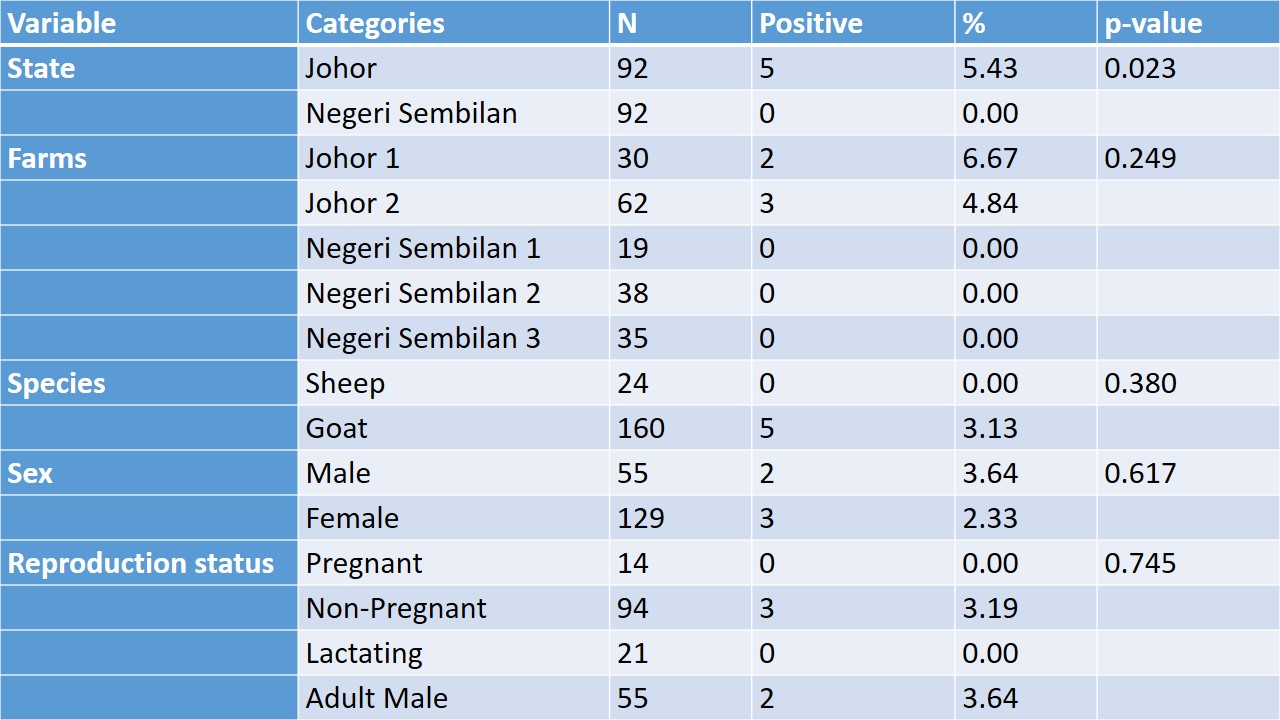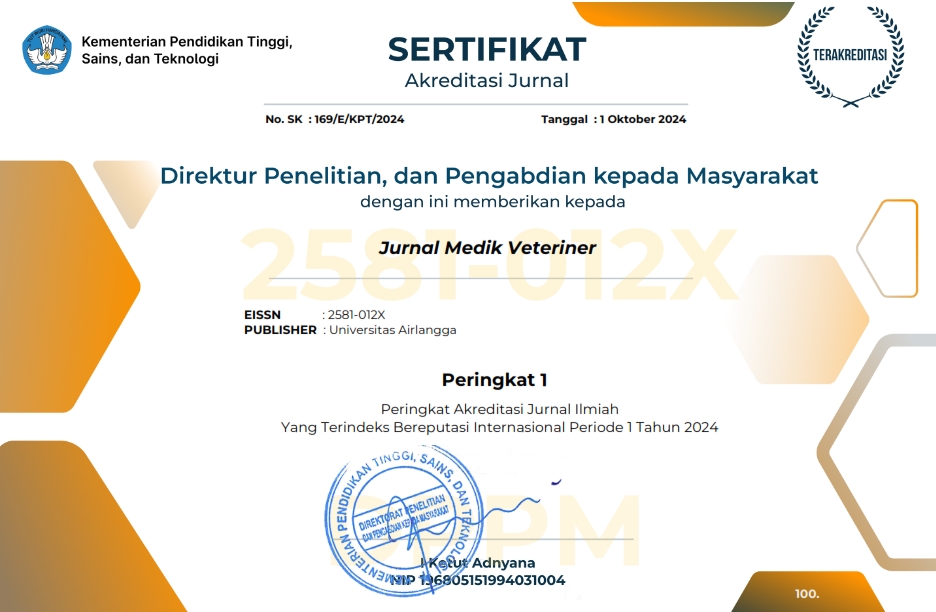Seroprevalence and Associated Risk Factors of Coxiella burnetti in Small Ruminants in Southern States of Peninsular Malaysia

Downloads
Q fever is caused by the bacteria Coxiella burnetii, a zoonotic disease that causes abortions and stillbirths in ruminants. The seroprevalence of Q fever in small ruminants, such as sheep and goats, can vary widely depending on geographical location, farming practices, and the prevalence of the disease in the area. The main objective of this study is to determine the prevalence of infectious reproductive diseases affecting the small ruminant population in the southern state of Peninsular Malaysia and its associated risk factors. The animals (n = 184), comprising 24 sheep and 160 goats, were from the states of Negeri Sembilan and Johor. Before sampling, a physical examination was conducted on the animal to establish its health status. An enzyme-linked immunosorbent assay was performed on the serum to detect the seroprevalence of infectious reproductive diseases in Q fever. Farm animal records and observations were designed to assess the risk factors associated with the prevalence of Q fever. The seroprevalence of Q fever in small ruminants was 2.7% (5/184). Male animals have a higher prevalence of Q fever at 3.63% (2/55) than female animals at 2.3% (3/129). Goats managed intensively were found to have a higher seroprevalence at 4.08% (2/49) than those managed semi-intensively at 2.17% (3/138). The state of origin factor was significantly associated with the seropositivity of Q fever. This study revealed the existence of low seroprevalence of Q fever among small ruminants in selected states and farms in Peninsular Malaysia. However, the low seroprevalence of Q fever suggests a persistent exposure to C. burnetti, which could present a public health threat and a substantial risk to the ruminant industry.
Amin, F., Ali, S., Javid, A., Imran, M., Rashid, M. I., Mertens-Scholz, K., & Neubauer, H. (2022). Sero-Epidemiology of Coxiella burnetii Infection in Small Ruminants in the Eastern Region of Punjab, Pakistan. Pathogens, 11(6), 664.
Bina Rai, S., Kamaludin, F., Chow, T. S., & Yoon, C. K. (2011). First Documented Zoonotic Case of Q Fever in Penang, Malaysia. Outbreak, Surveillance, Investigation & Response (OSIR) Journal, 4(1), 1–5.
Bontje, D. M., Backer, J. A., Hogerwerf, L., Roest, H. J. W., van Roermund. (2016). Analysis of Q fever in Dutch dairy goat herds and assessment of control measures by means of a transmission model. Preventive Veterinary Medicine, 123, 71–89.
Dobos, A., Fodor, I., Kiss, G., & Gyuranecz, M. (2021). Serological survey of Coxiella burnetii infections in dairy cattle, sheep, goats and zoo animals in Hungary - Short communication. Acta Veterinary Hungarica, 69(2), 105–109.
Doeschl-Wilson, A., Knap, P. W., Opriessnig, T., & More, S. J. (2021). Review: Livestock disease resilience: from individual to herd level. Animal, 15(Suppl 1), 100286.
Doung-Ngern, P., Chuxnum, T., Pangjai, D., Opaschaitat, P., Kittiwan, N., Rodtian, P., Buameetoop, N., Kersh, G. J., & Padungtod, P. (2017). Seroprevalence of Coxiella burnetii Antibodies Among Ruminants and Occupationally Exposed People in Thailand, 2012–2013. American Journal of Tropical Medicine and Hygiene, 96(4), 786–790.
Eldin, C., Mélenotte, C., Mediannikov, O., Ghigo, E., Million, M., & Edouard, S. (2017). From Q fever to Coxiella burnetii infection: a paradigm change. Clinical Microbiology Review, 30(1), 115–190.
Jesse, F. F. A., Paul, B. T., Hashi, H. A., Chung, E. L. T., Abdurrahim, N. A., & Lila, M. A. M. (2020). Seroprevalence and risk factors of Q fever in small ruminant flocks in selected States of Peninsular Malaysia. The Thai Journal of Veterinary Medicine, 50(4), 511–517.
Karagul, M. S., Malal, M. E., & Akar, K. (2019). Seroprevalence of Q Fever in Sheep and Goats from the Marmara Region, Turkey. Journal of Veterinary Research, 63(4), 527–532.
Khonmee, J., Brown, J. L., Li, M. Y., Somgird, C., Boonprasert, K., Norkaew, T., & Thitaram, C. (2019). Effect of time and temperature on stability of progestagens, testosterone and cortisol in Asian elephant blood stored with and without anticoagulant. Conservation Physiology, 7(1), coz031.
Khoo, J. J., Lim, F. S., Chen, F., Phoon, W. H., Khor, C. S., Pike, B. L., Chang, L. Y., & AbuBakar, S. (2016). Coxiella Detection in Ticks from Wildlife and Livestock in Malaysia. Vector Borne Zoonotic Diseases, 16(12), 744–751.
Khor, C. S., Mohd-Rahim, N. F., Hassan, H., Chandren, J. R., Nore, S. S., Johari, J., Loong, S. K., Abd-Jamil, J., Khoo, J. J., Lee, H. Y., Pike, B. L., Wong, L. P., Lim, Y. A., Zandi, K., & AbuBakar, S. (2018). Seroprevalence of Q Fever Among the Indigenous People (Orang Asli) of Peninsular Malaysia. Vector Borne Zoonotic Diseases, 18(3), 131–137.
Nugroho, E. P., Setiyono, A., Hadi, U. K., Winarsih, W., & Astuti, D. (2021). Immunohistochemical Detection of Coxiella burnetii in Cattle Spleen Organs from Ampel Slaughterhouse, Boyolali Regency. Jurnal Medik Veteriner, 4(1), 48–55.
Pexara, A., Solomakos, N., & Govaris, A. (2018). Q fever and seroprevalence of Coxiella burnetii in domestic ruminants. Veterinary Italiana, 54(4), 265–279.
Rahravani, M., Moravedji, M., Mostafavi, E., Mohammadi, M., Seyfi, H., Baseri, N., Mozoun, M. M., Latifian, M., & Esmaeili, S. (2022). The epidemiological survey of Coxiella burnetii in small ruminants and their ticks in western Iran. BMC Veterinary Research, 18(1), 292.
Rizzo, F., Vitale, N., Ballardini, M., Borromeo, V., Luzzago, C., Chiavacci, L., & Mandola, M. L. (2016). Q fever seroprevalence and risk factors in sheep and goats in northwest Italy. Preventive Veterinary Medicine, 130, 10–7.
Rush, E. R., Dale, E., & Aguirre, A. A. (2021). Illegal Wildlife Trade and Emerging Infectious Diseases: Pervasive Impacts to Species, Ecosystems and Human Health. Animals, 11(6), 1821.
Schimmer, B., de Lange, M. M., Hautvast, J. L., Vellema, P., & van Duynhoven, Y. T. (2014). Coxiella burnetii seroprevalence and risk factors on commercial sheep farms in The Netherlands. Veterinary Record, 175(1), 17.
Tabita, T. (2022). Cabicompendium.66416, CABI Compendium, CABI International, Q fever.
Tagesu, T. (2019). Q Fever in Small Ruminants and its Public Health Importance. Dairy and Veterinary Science Journal, 9(1), 555752.
Ullah, Q., Tariq, J., Muhammad, S., Mudassar, I., & Heinrich, N. (2022). ‘Q Fever—A Neglected Zoonosis’. Microorganisms, 10(8).
Villari, S., Galluzzo, P., Arnone, M., Alfano, M., Geraci, F., & Chiarenza. (2018). Seroprevalence of Coxiella burnetii infection (Q fever) in sheep farms located in Sicily (Southern Italy) and related risk factors. Small Ruminant Research, 164, 82–86.
Winter, F., Schoneberg, C., Wolf, A., Bauer, B. U., Prüfer, T. L., Fischer, S. F., Gerdes, U., Runge, M., Ganter, M., & Campe, A. (2021). Concept of an Active Surveillance System for Q Fever in German Small Ruminants-Conflicts Between Best Practices and Feasibility. Frontiers in Veterinary Science, 8, 623786.
Zarza, S. M., Mezouar, S., & Mege, J. L. (2021). From Coxiella burnetii Infection to Pregnancy Complications: Key Role of the Immune Response of Placental Cells. Pathogens, 10(5), 627.
Copyright (c) 2025 Nur Aisyah Ismael, Wan-Nor Fitri, Nur Husna Abdul Rahman, Zulkhairi Azizi Zainal Abidin, Faez Firdaus Abdullah Jesse

This work is licensed under a Creative Commons Attribution-NonCommercial-ShareAlike 4.0 International License.
Authors who publish in this journal agree to the following terms:
1. The journal allows the author to hold the copyright of the article without restrictions;
2. The journal allows the author(s) to retain publishing rights without restrictions;
3. The legal formal aspect of journal publication accessibility refers to Creative Commons Attribution-NonCommercial-ShareAlike 4.0 International License (CC BY-NC-SA).






11.jpg)




















